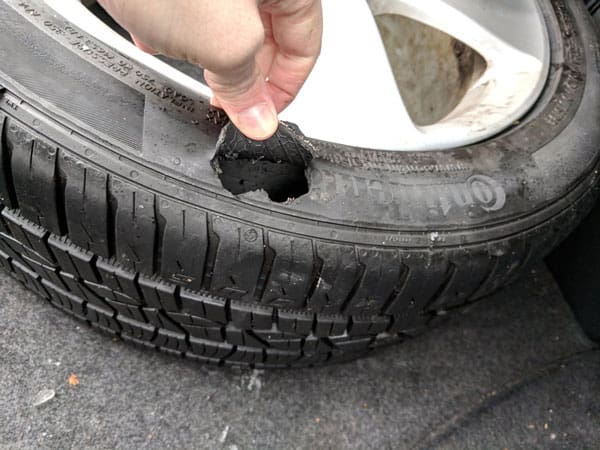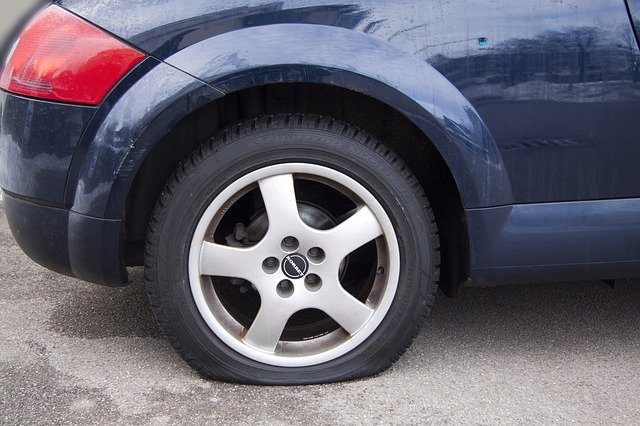Table of Contents
Why Do My Car Tires Keep Losing Air Or Going Flat?
It can be frustrating if your tires keep losing air or going flat where there is seemingly nothing wrong with your tires. But sometimes finding what is causing your tires to lose air is not that easy. Sometimes it’s not the tires fault for losing air and it is actually a problem with a bent rim.
So what should you do if your tires keep losing air? If you have one tire or multiple tires losing air then you would want to inspect them for punctures, a damaged tire bead, a faulty valve stem, or damage to the sidewall of the tire. Damage to your wheels can also cause your tires to lose air.
Now that you know what can cause tires to lose air what can you do if you have a tire that is currently losing air? What’s the best way to fix a tire with a slow leak? What’s the best way to pinpoint what is causing your tire to lose air? These questions answered and more below.
Most Common Reasons for a Tire to Keep Losing Air – What Causes Tires to Lose Air?
-Tire Puncture
One of the most common reasons for a car tire to keep losing air is a punctured tire. Your tires can pick up nails and screws on the road relatively easily.
Any sharp piece of metal on the road can puncture your tires allowing them to lose air. Sometimes your tire will lose air rapidly if the puncture hole is large but if the puncture is small and the nail or screw are still lodged in the tire tread it can result in a slow air leak.
-Bent or Damaged Wheel Rim
Another common reason for a tire to keep losing air and going flat is a damaged wheel rim. Your tires are designed to create an airtight seal around the outer lip or rim of your wheels. If you hit a pothole or other large bump and bend your wheels your tire can have trouble properly sealing around the wheel which can cause your tire to lose air.
-Damaged Tire Bead
Your wheels aren’t the only thing that can be damaged by debris in the road, your tires can also be damaged
The tire bead on your tires is designed to create a seal around the lip of your wheel to hold in air. If the bead on your tire becomes damaged from debris in the road it can also allow your tires to lose air.
-Potholes or a Hard Impact
Hitting a pothole at high speeds can cause immense amounts of pressure on the sidewalls of your tires which can damage the sidewall of the tire allowing the tire to slowly lose air. Hitting a pothole hard enough can also cause your tire tread to be slammed into the side of your rim damaging the sidewall of the tire and allowing air to escape. You may even have a complete sidewall blowout if you hit a large enough pothole going fast.

Tires can also be damaged if they are slammed into a curb. If you’ve recently accidentally hit a curb with your tires then you’d want to inspect them to damage to see if they are allowing air to escape.
-Damaged Valve Stem
Another common area for air to leak out of your tires are valve stems. Valve stems are made of rubber and can become brittle over time, they can also develop cracks and allow air to escape from the valve stem. The good news is that replacing a valve stem is fairly inexpensive and is a job that can be performed by most tire shops.
-Sidewall Damage
Tires can also have sidewall damage that can allow air to escape. If you hit a large enough pothole your wheel can slam into the pavement and onto the sidewall of your tire damaging it and allowing the tire to lose air. Tire sidewalls are also susceptible to bubbling which is when the sidewall (that usually is flat) has a bubble pop extruding from the side of your tire. Once a tire has a bubble on the sidewall it would need to be replaced as tires with damaged sidewalls can’t be repaired.
-Vandals
Have you made anyone mad recently? Vandalism can be another reason why your tires keep going flat. Inspect your tires for signs of tampering, it could just be neighborhood kids letting air out of your tires as a prank. Obviously, if you come outside to your car one day and your tires are slashed, it’s more than just a prank and you’d want to get law enforcement involved.
-Worn Tires
Tires can also wear down so badly that they can allow the tire to go flat. If you haven’t had the alignment on your car adjusted in a long time it can allow abnormal wear to occur on the inside or outside of your tires. Allowing this sort of wear to go on long enough can allow the tire tread to be worn down all the way to the metal underneath the tire tread. When this happens your tires will need to be replaced soon as the risk for having a blowout would go up substantially.
How Do I Know If My Tire Has a Leak?
The easiest way to determine if your tire has a slow leak is by using water to try to find the leak. To do this you would want to remove whatever wheel you suspect has a leak from your vehicle. Using a bucket of water splash water onto the tread of your tire to see if you can hear or spot air escaping from the tire.
You should be able to see air bubbles if there is a puncture in the tire or be able to hear the air escaping from the tire. If you don’t see any indication in the tire tread that you have an air leak then you’d want to check your tire sidewalls to see if there is any indication of air escaping from the sidewall of the tire using the same method of splashing water on the tire.
If you can’t locate the air leak using water on the tire tread or tire sidewall then you’d want to turn your attention to the valve stem. The valve stem that allows you to air up your tires can also allow air to escape if it’s faulty or has been damaged. Inspect the valve stem attached to your tire, can you hear any air escaping from the valve stem, you can splash water on the valve stem to spot air bubbles escaping to make the task easier.
If you can hear or feel air escaping from the valve stem then you would want to have the valve stem replaced. Most tire shops can replace the valve stem on a tire fairly cheaply.
What Should I Do If My Tire Has a Slow Leak?
When your tire has a slow leak you have a couple of different options to get the air leak fixed, depending on why the leak is occurring in the first place.
If the leak occurred from a puncture in the tread of the tire then you can have your tire patched to keep it from leaking again in the future. I’ve had to have this done on one of my tires and the tire patch worked well, I don’t have to keep airing up my tire because it isn’t losing air.
If you’ve had your tire patched previously and you can’t spot any problems with your tires then it could be that the patch is failing and needs to be redone.
How To Prevent Being Stranded From a Low Tire Pressure
Most people know that driving without air in their tires would damage their wheels and tires. But the good news is that you can take action to help keep you from getting stranded with a flat tire.
I’d recommend investing in a portable tire inflator that can inflate your tires from virtually anywhere. Portable tire inflators get power from your car’s cigarette lighter and allow you to inflate your tires if you continually have a slow leak.
Portable tire inflators are also helpful if you have a tire puncture when whatever caused the puncture stays lodged in the tire (which is most of the time from my experience). When a screw or nail gets picked up by your tire tread and stays stuck in the tire tread it can work as a temporary plug and allow you to inflate your tire so that you can get to the tire shop to have the tire patched or replaced.
Obviously, if you have a nail in your tire you wouldn’t want to go for a long drive. But it can at least get you back on the road long enough to get your tire repaired without needing to swap out your tire with your donut or call for a tow.
-Include a link for a portable tire compressor/inflator
Is It Safe to Drive on a Tire with a Slow Leak?
Yes, it’s relatively safe to drive on a tire with a slow leak as long as there is no damage to the tire that could allow it to blow out while driving. You’d also want to pay close attention to the level of air in the tire to make sure that it doesn’t get so low that you damage your wheel.
If you have a nail embedded in your tire tread then it should be safe to drive on until you can take your car to a tire shop to have them patch your tire. But if you have damage to your tire sidewall or your tread is falling off your tire then you’d want to have the tire replaced before driving your car again.

